
FOUNDATION ART AND DESIGN: FINE ART
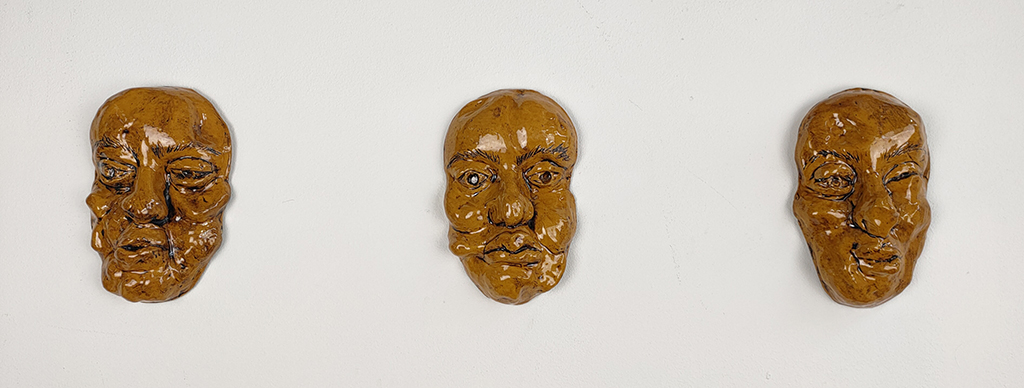
Fatima Akhtar
Previous Education: The Earls High School and King Edward VI College
Destination: BA (Hons) Fine Art at Manchester Metropolitan University
“Narcissism” is a project exploring the way we criticise our observations of our reflections. Due to lockdown, communication has altered significantly. Video calling and sending messages through photographs and short videos has become more prominent. However, our images on screens are not authentic as there is a slight distortion of features. Whether it be the nose looking slightly wider, the forehead looking slightly bigger or the chin looking too wide, there is something you want to change or hide in the image. This could be by altering the image through editing or using filters. This self-judgement causes us to constantly act in a way that abides to social norms by putting on a mask, a way to conceal our true selves through a persona.
This inspired me to look at exaggerating and manipulating the face, firstly through photoshoots, influenced by Ana Mendieta and Wes Namen, by pushing and pulling the skin. I developed this theme into working with clay to form masks of the face. This led to creating a persona with an Instagram account for the mask, named “Clayton”, inspired by Grayson Perry’s “Claire”. On the Instagram page, I explored the use of filters to show how we try to look our best to fit in by hiding behind these “beautifying” filters. Laura Mulvey’s “Male Gaze” theory is applicable to my project as the idea of depicting a person in a way to satisfy others is prominent through the development of ideas.
By having regular one-to-ones with teachers, I received suggestions for more artists and theories to research and explore. This was useful for the development of my contextual research, which gave me more of an understanding on my topic. Group crits were extremely useful in ensuring my work conveyed what I wanted it to. This feedback informed me on how “Clayton’s” Instagram could be developed further by amplifying the filters to increase the distortion. Unfortunately, I have not been able to present the ceramics masks in a mock up exhibition setting, such as exhibiting the masks on sticks, or on a wall in front of a front facing camera encouraging viewers to take selfies with the ceramics exploring the filters, due to the lack of time, space, and resources.
This project has given me a greater understanding of the process of making ceramics of a face, including the initial casting procedure of my own face, creating a negative mould using rubber, using specialist clay tools to shape the clay, and learning the science behind glazing and oxides. Considering I have not worked with clay prior to this project, I am pleased with the results, and I continue to plan to improve and use these new skills at degree level. The Foundation Art and Design course had taught me how to independently manage a project by showing me how to be confident in my decisions and experiment with ideas and materials that I may not have thought of at first.
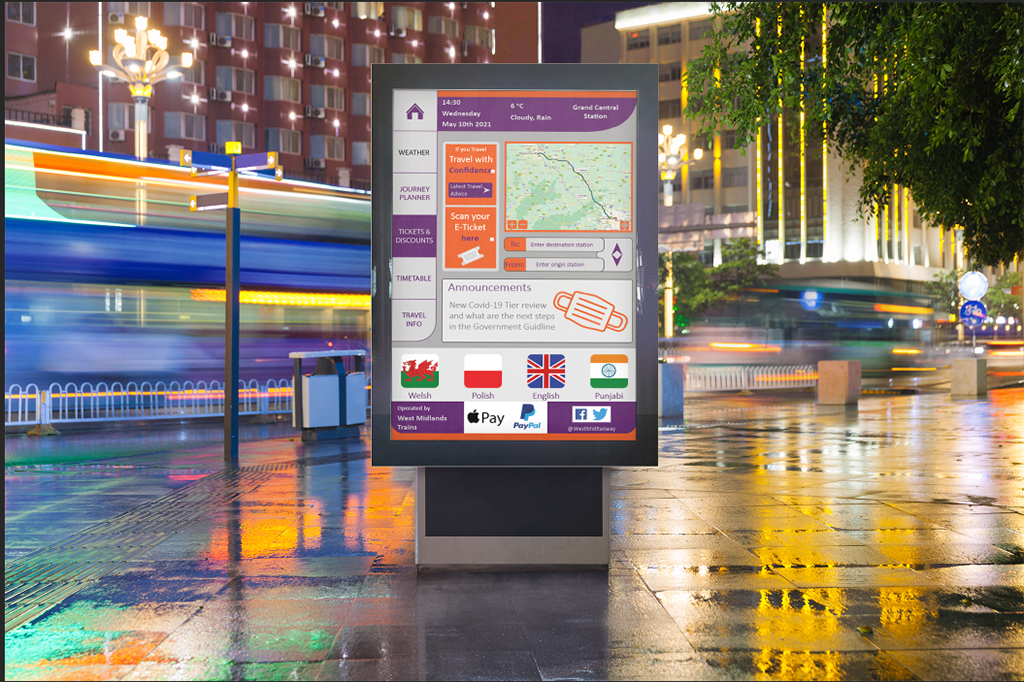
Ikhlars Bashir
Previous Education: Orminston Forge Academy and King Edward VI College
Destination: BA (Hons) Architectural Engineering at Loughborough University
My project “Connections” focusses on the different ways public spaces can be enhanced to create a better environment for society and design in COVID safe behaviours. I have explored different areas of both psychology and sociology that are not considered in modern public design. It is about improving these spaces and areas of interaction so that it can be safer, controlled but also give the user a better experience.
Transport Hubs were the initial model I had in mind, places where there is a high and consistent flow of people. I envisaged my designs for these spaces would hopefully also change behaviour in other public realm spaces. Development began with seeing different designs and concepts where I initially focused on Industrial Design.
My contextual research started with research into prestigious companies such as Grimshaw Architects and Zaha Hadid and looking at their work made me think more practically at what my ideas could do. Further research introduced me to different technologies I could incorporate into my design to improve the user experience as well as making the current spaces more COVID safe. Research into Philippe Starck prompted a design for an interactive ‘totem’ information panel. This became my focus and further reflection and research pushed me to expand upon the idea.
The designers I researched helped not only with inspiration for my designs and concepts but also with the mindset I needed to adopt to solve problems. I needed to change my outlook towards my work, to focus on how best my design skills could help the public. The graphics needed to be intuitive and send messages with clarity and assertion. I used the NHS format so the messages presented were coherent and consistent with national information but my ideas could be adapted locally. With this in mind he User Interface design was modelled with the brand colours of the West Midlands Railway in mind.
My project quickly developed from a single idea to a design for a public environment, which took into more consideration into psychology of how the public interact in congested spaces. Input from my tutor and peers has informed me when I have gone too far down a path, using a second perspective to smooth out my design and I have benefitted from taking many perspectives on board.
Throughout my FMP I have learnt that multiple software and visualisation techniques can help communicate my ideas to a broader public. I feel that my overall design answers the questions I outlined in the beginning of this and poses more questions to answer that I have expanded upon in my final reflection. Timing and managing my work ethic have been an important skill the FMP has taught me and I feel more confident now as I enter Higher education to produce work of a consistent quality and meet deadlines more comfortably.
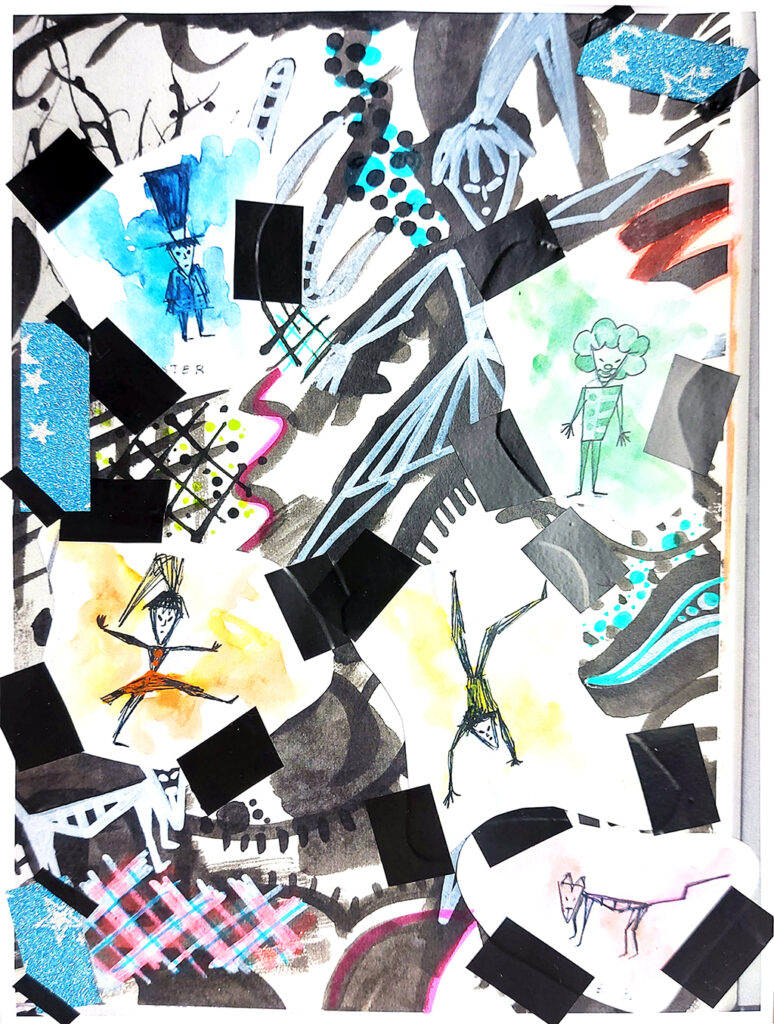
Daisy Dodson
Previous Education: Perryfields Academy
Destination: Employment
“Ex Circo Ludios a Profundis Inferni” is a horror circus created within my refined horror theme. Initial ideas included experiments with ticket design, poster design and manipulating versions of traditional ideas of the circus.
Through simple illustration and drawing techniques, I was exploring the distortion of reality and incorporating horror into what is supposed to be friendly and fun. I was inspired by a simple circus ticket; and through manipulation was able to connect to what was ‘typical’, with dreams, sleep, nightmares and vulnerability.
What is it that makes fear friendly? What makes us go back watch horror movies again and again? Submerging ourselves in another world watching a movie or reading a book; feeling the apprehension before the climax, feeling the frustration during the dilemma; the relief when the credits roll, even if that feeling of apprehension stays with you. It is the familiarity, how we know what is coming, but are there, feeling it anyway. It is that familiarity I am fascinated by.
Through the project I developed a deeper understanding of how imagery can affect an audience. That within the expectancy, you can still surprise people.
It was group crits and tutorials that helped me with this understanding. Group crits were extremely useful for practical reflection and getting feedback about, “What could I do next? Where could I take this?”. Tutorials were helpful because I picked up the names of artists that would influence my work. The combination of both meant I was able to steadily work through my project and bring it together in an intelligent and coherent manner.
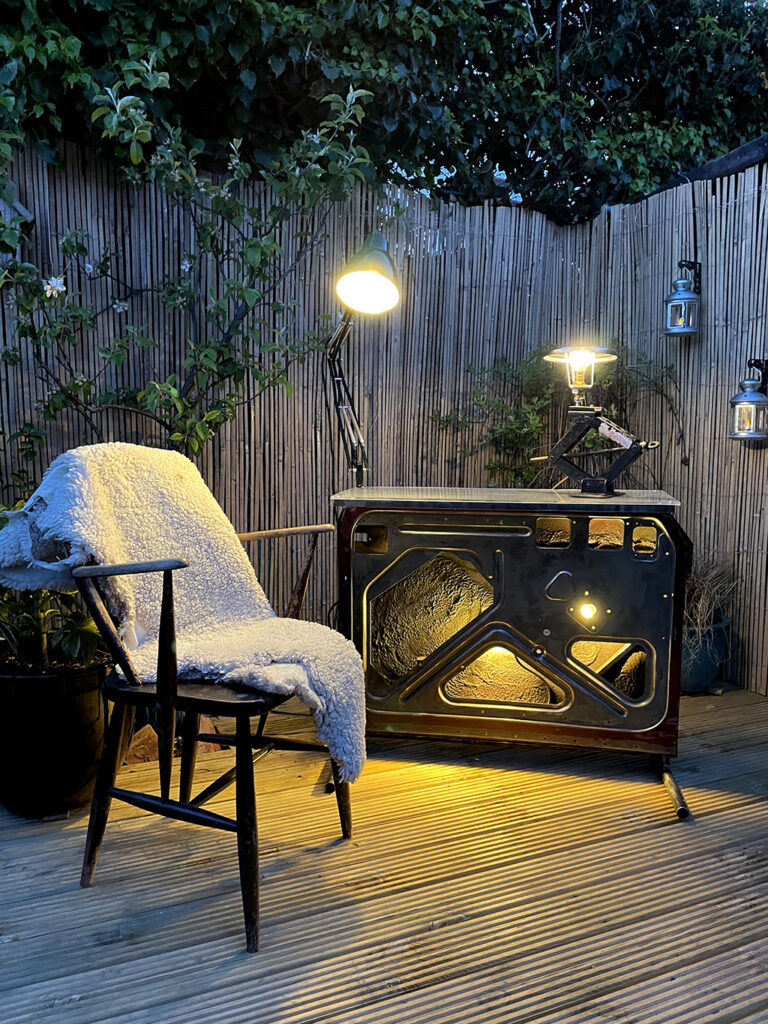
Martha Hipkiss
Previous Education: Redhill School and King Edward VI College
Destination: BA Hons) Architecture at Nottingham Trent University
“Landfill Innovation” is a project to encourage upcycling solutions for discarded objects and showing how these mundane items could acquire innovative, new purposes. Deterring the use of landfill is paramount in preserving the fragile world, so finding sustainable solutions to everyday problems limits discarded waste. I have always been interested in eco-conscious ideas and have always incorporated these into my designs. Not only is this concept positive from an environmental stance, but it also forced me to create alternative designs based around the materials I had to expend. I chose to explore this idea through furniture design and how unwanted items could be manipulated to become a useful asset in the home.
After collecting various odd items, I started to experiment with how these could be combined to perform a function for the home. “Messgewand Maximalist Furniture” is a series of surreal furniture pieces made from collaged found objects. The form these objects create when united intrigued me, prompting me to consider shape and structure in my own design. As well as being visually appealing, functional seating is incorporated which interests me from a practical perspective. Advocating the importance of sustainability meant portraying this concept through the materials I had gathered by being recycled, given a new purpose and rebelling against consumerism. Artist Bill Woodrow follows a concept of creating sculptural pieces with metaphorical messages commenting on society, consumerism and subverting typical functions of the found objects used. This went with my final piece, the Car Door Side Table, of undermining the classic meanings of found objects and placing them in an opposing context.
Considering contrasting views from my peers and tutors, helped me refine my ideas to what practically and visually works in my design. Further suggestions to what artists, concepts, or artworks I could explore, helped me to develop my understanding of the topic by collating different views and interpretations of the design and environmental world. I feel I could have developed my practical experimentations further by including solutions that were not all seating pieces. This would explore the extent of what these items could become and allow their natural form to decide their best function. If I had had more space, time, and resources to let the process of this happen, I would have spent more time experimenting with this.
My FMP has allowed me to develop my practical skills in working with different materials in the workshop and performing different processes. I feel more confident in my abilities and feel I can now apply these learnt processes to my designs in the future with certainty. FAD has taught me to critically evaluate myself, taking time to reflect on my decisions to better my concept and design results. This will be a skill that can be applied to my undergraduate course, as scrutinizing my work allows me to progress as a designer by informing my decisions and problem solving any issues.
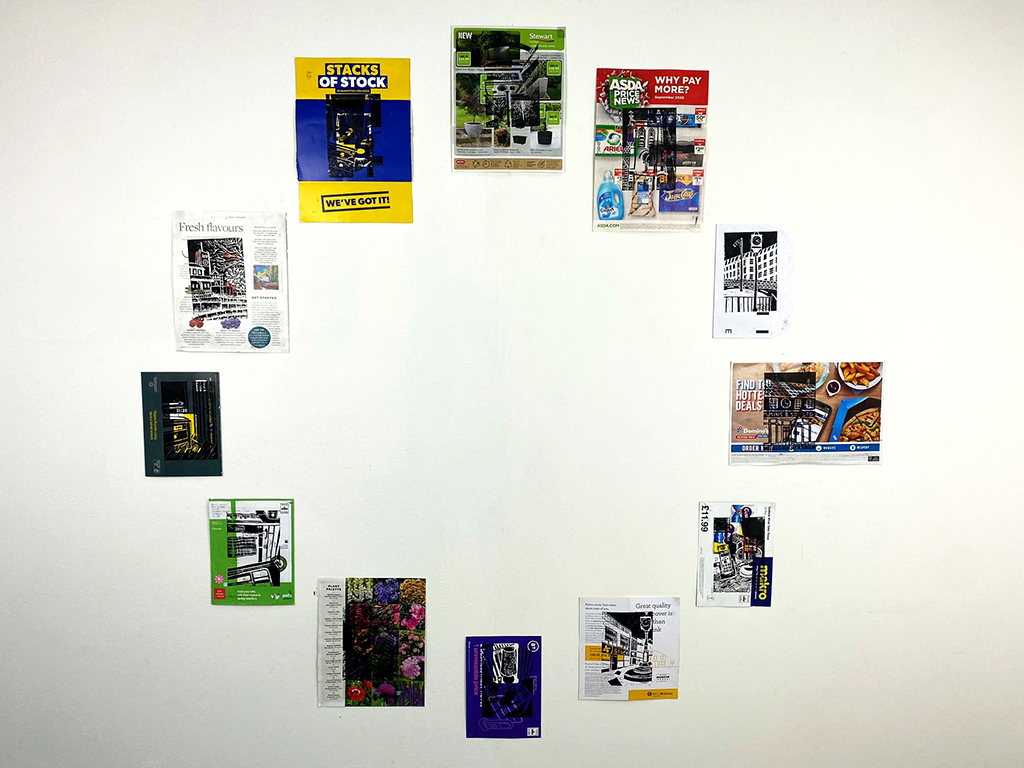
Abigail Jefferson
Previous Education: The Earls High School and King Edward VI College
Destination: Education and Psychology BA (Hons) at University of Worcester
Within my project ‘Mundane Time’, my ideas came from lockdown and being at home. At the start of the project, I gathered quotes from friends and family members to get their thoughts on it. The idea of it being difficult and repetitive came to my attention. I gained inspiration from Richard Billingham’s photographs of everyday life at home and took my own photos which helped me to show how repetitive life had become, being in the same places. I created a lino print of a view out a window at home. I thought this felt like a barrier between us being inside and the outside world. I printed this several times to create a series, fading the colour each time to show lockdown gradually feeling duller.
As my work developed, it was mainly about time, as we seemed to notice the time more in lockdown, noticing clocks and realising how we can no longer spend our limited time how we want to in lockdown. The idea of memento mori became significant and Marclay’s twenty-four-hour film ‘The Clock’ inspired me to begin taking photos that include the time in them, from scenes at home and also whilst out in my local area.
Regular discussions with tutors during my project helped with my contextual and artist research as I was introduced to many artists such as Giorgio Morandi. His work made me think about my use of colour. Blended learning tasks we were set and discussions on these introduced me to concepts too such as memento mori and NFT’s which helped with my contextual research. Feedback on work from tutors and peers gave me ideas on what I could try out to improve and helped me to reflect on my choices. For example, the group crits gave me suggestions on how I could improve my final prints onto mail.
I think I could have developed my project further by trying to print with coloured ink, carving out my designs in layers, as I could have experimented with colour this way too. I achieved what I proposed to as my different studies explore the repetitiveness of lockdown and how we are more aware of time. I planned for most of my outcomes, however some ideas came to my attention after I’d produced my final outcome, such as how I could make my prints blend in more to the mail. I wanted to do this so it would take longer for the audience to see the print, taking more time and emphasising the time we felt that we wasted in lockdown.
Key things that my FMP has taught me include how it is important to regularly review my ideas and decisions so I know how to move forward. It has enabled me to improve on explaining my work and ideas more confidently to others. FAD has also taught me how to independently direct my work through my projects. I will take forward these skills which will help my learning to develop at university.

Lucy Blue Lloyd
Destination: BA (hons) Fine Art Liverpool John Moores University
“A Media’s Portrayal of HIV/AIDS” is a project about the discrimination and segregation of homosexual men during the 1980’s AIDS epidemic. In this project I wanted to explore the damaging effects that were created by the homophobic and prejudice media that were reporting on the virus. Therefore after briefly researching this, it became evident that we as a society have improved drastically in regards to being more accepting and understanding. When the AIDS/HIV virus started to infect more people the media blamed homosexuals for the disease, even going as far as naming it the ‘Gay Plague’. This was a major catalyst in regards to homophobic behaviour within our society, gay men were being removed and alienated from their communities and abandoned by friends and family. Initially, I was inspired to research the epidemic after observing how the media reported the Coronavirus, I was curious to compare how society has changed when reporting victims. The concept of this project was also inspired by channel 4’s ‘It’s a Sin’, a program in which explored the direct effects of the social injustice during the AIDS/HIV epidemic. The programme allowed us as the audience to witness just how much homosexual men at that time had to suffer through. Whilst watching the show I was able to see the effects from a more personal perspective, this helped me massively as I was then able to paint the emotions that I had seen through the characters giving my paintings a greater sense of authenticity.
Inspired by photographer Nan Goldin, I wanted to create a body of work which explores the intimate aspects of men within the LGBTQ+ community. I was also inspired by contemporary artist Marlene dumas after reading her book ‘One Hundred Models and Endless Rejects’, she is another artist who similar to me paints the people who have been rejected from society. I have also looked at Conor Harrington and Kathleen Ryan for aesthetic inspiration, Harrington’s use of contrasting colours definitely influenced me when creating my final portraits. Throughout my work I have consistently used red and blue hues to portray the varied emotions in which my subjects would’ve been experiencing, creating a vulnerability within each composition.
When sharing my work with other peers and teachers I have always been recommended new artists to look at or techniques to try. Group crits have allowed me to view my project through other people’s perspective, this has enabled me to see whether my work is still effective to a different audience. This itself has given me the confidence to present my ideas in a more coherent manner. The quotes that I had incorporated within each painting from news articles from the 1980’s, became increasing more important in allowing people to see just how much the words had impacted people’s lives. Unfortunately I have had limited sources due to Covid-19 restrictions, therefore if I had more time I would love to visit specific library’s in which archive more rare media coverage of the AIDS/HIV virus. This project has given me a greater understanding of how different painting techniques can alter the overall impact of a composition, I plan to develop this knowledge at degree level and beyond.
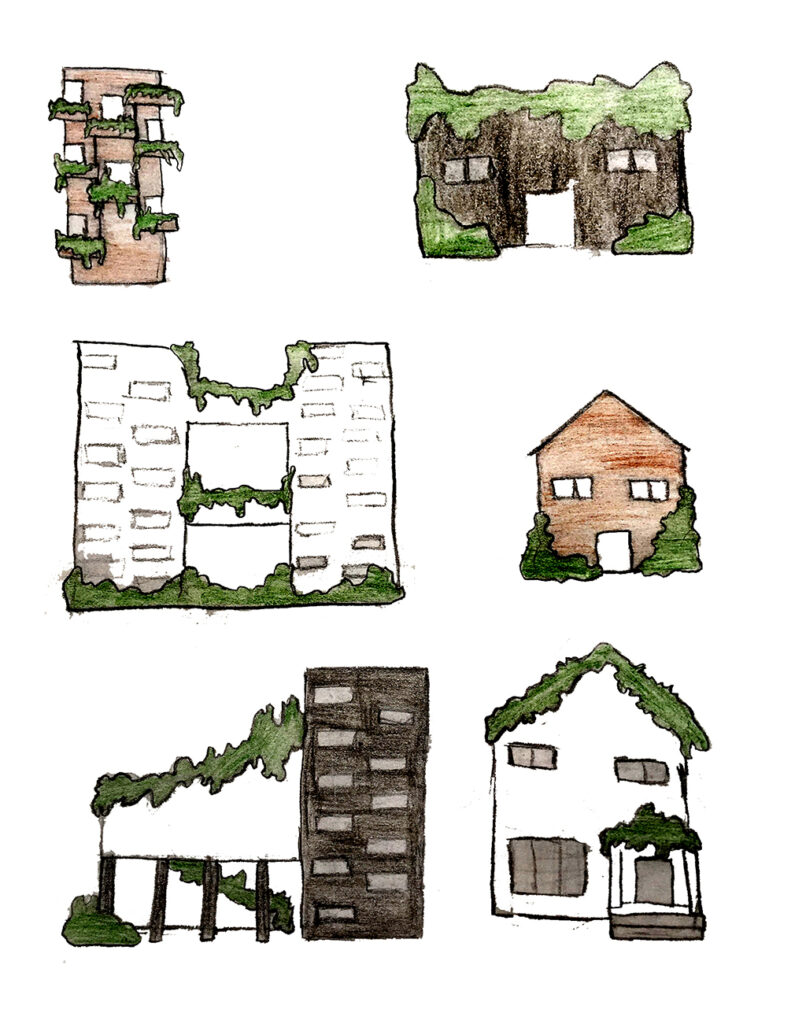
Ella May Miller
Previous Education: Ounsdale High School
Destination: Apprenticeship
My Final Major Project is all about the negatives of living in England, particularly the issues associated with social housing. I have made a series of drawn and sculptural proposals that look at how old buildings can be sub-divided in to houses of multiple occupancy and how this can affect basic human rights to light, space and privacy.
I wanted to create a piece that inspired people to learn more, to lesser the ignorance that we have here and to maybe suggest ideas on how I would go about trying fixing problems of inequality, both an artist and an individual.
I was inspired by two previous projects in particular: First the fashion and textiles Final Major Project (FMP) on my previous course ‘The Genderless Collection’. This project highlighted to me the restrictions and pressures that are put on people over something as trivial as clothes. Dismantling these structures is something that personally interests me.
Talking to staff or peers often gave me further artists to look at or approaches to take in order for my project to develop further. It was interesting to listen to the different ways that people interpreted my project as it helped gain insight on whether my project was working in the way I had intended, as well as possible ways to improve it that I might have overlooked.
During this year we had to complete the previous assignment and start the FMP at home, both of these projects have improved my resourcefulness and ability to prioritise when working on practical work. I hope to further develop these skills as well as improve on my time management and working in a group in the future.
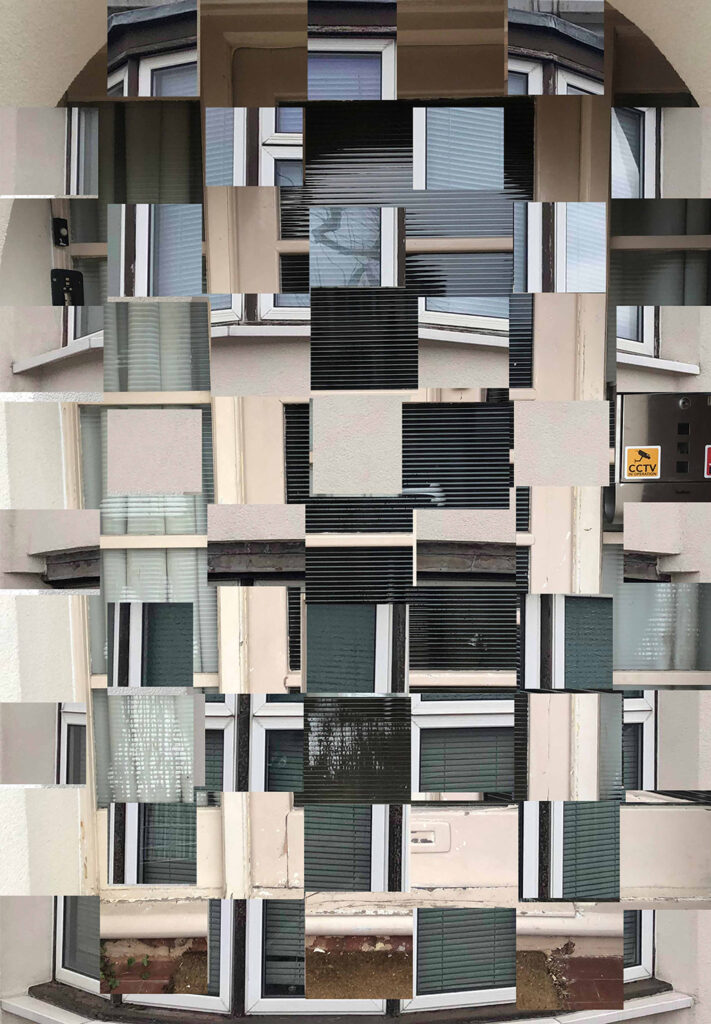
Emellia Neale
Previous Education: Stoke Damerel Community College
Destination: Gap Year with part time employment to explore further education options
“Distortion” is a project about the manipulation and distortion of image and sound. Within this project I wanted to explore how the distortion of things can make them familiar yet unknown creating a sense of confusion for the viewer. I wanted my work to enforce a liminal space and communicate the uncanny, a term first used to describe work by the surrealists.
Through the development of ideas and context I decided to explore how different sounds and visuals from around my house have changed through being in lockdown for so long. Through research this idea developed into investigating how the house has become a guard or shield between the inside and outside world due to Covid-19. I have wanted to communicate my thoughts and feelings of how I have experienced lockdown and the way it has made me feel. Doing this has enabled me to present my own perspective to the audience and allowed them to experience the work through my eyes.
I was initially inspired by the work of Greg Sand and Anthony Gerace and how the way their work visually communicates the look of a glitched or pixelated image by sectioning an image into individual squares. I felt that exploring this technique would allow me to signify how lockdown and covid-19 has felt like a ‘glitch’ in reality.
Initially my project was developing into more of a photographic and sound piece that was going to become a static image, however through development and problem solving I decided to develop it by pushing it out of photography and into 3D I did this by transferring my images onto different textured materials such as wood and plaster. This allowed me to create a link between images of a house being printed onto materials a house is made out of.
Speaking to my peers or my tutors has allowed me to get suggestions of different artists and designers that have given me inspiration or helped aid the development of ideas within my work. It has also been useful to get the opinions of others as this allows me to see if my work is communicating what I want it to.
On reflection, I believe my photographical distortions communicate my original message of the liminal space between familiar/ unknown however, I feel this message has been lost slightly though the development and transfer of my images onto different materials.
Throughout the FMP I have learnt and developed a range of skills such as; photoshop, image transfer and how to develop and expand on an idea through technique or context. The most important skill fad has taught me is how to manage my time most effectively. This has allowed me to work independently, be in charge of my own learning, and work to a timescale that ensures the work made best illustrates my intentions.
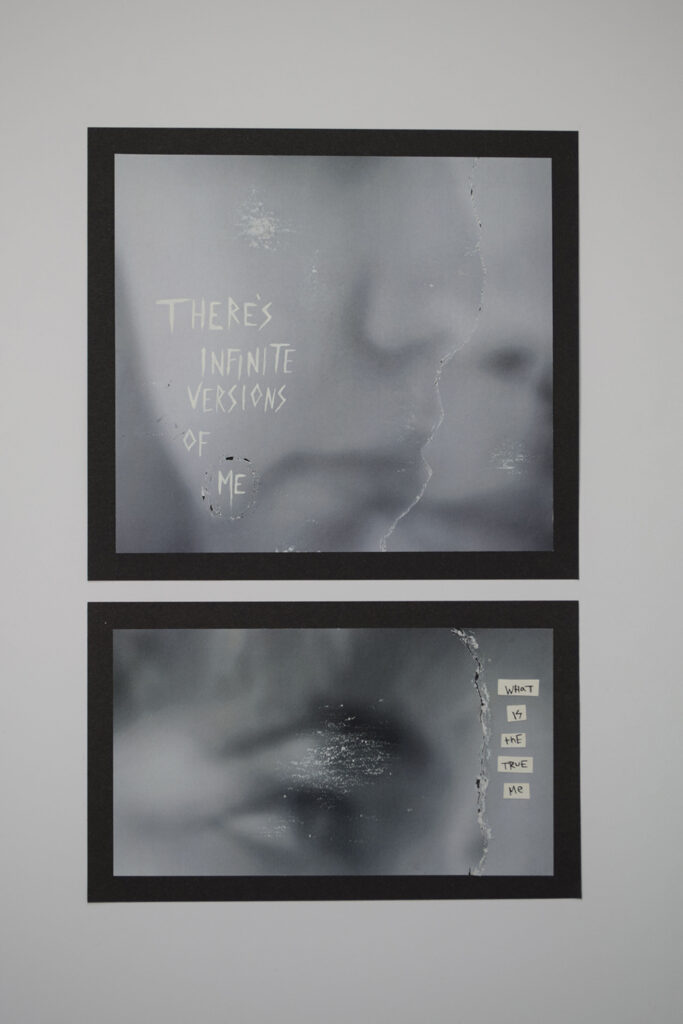
Rose Priest
Previous Education: Pedmore High School
Destination: BA (Hons) Fine Art Leeds Arts University
‘There’s Infinite Versions of Me’ is a project that attempts to explore identity and the complexities of it.
The body of work I have presented is a series of photocollages that I have produced through cutting up, moulding and abstracting close-up portraiture photography. The work includes instinctive mark making and typography and uses traditional dark room processes as well as digital manipulation.
I have tried to talk about my identity from other perspectives than my own, how truth is subjective, and how the ‘true’ version of you in someone’s reality is their truth but not yours. An example of this is if someone hasn’t seen you for a long amount of time, they still have a ‘past’ image of you that could be very different to how you now are. Their image of you still however ‘exists’.
I have tried to explore how everyone has a different perception of their own identity and how we are different in everyone else’s reality. I have also been intrigued by how I feel about the different versions of myself that I present to others.
At the beginning of the project, I was asking broad ranging questions surrounding truth and whether there is a ‘true’ version of us. I wanted to home in on the fact that there may be a ‘true version’ of me and speculate how presenting this may alter the other versions people may have of me. As I researched further and developed practical aspects of the project, I searched for new techniques to visualise these quite abstract ideas.
The main artist’s inspiration for this project has been Frank Lebon, he is a mix media graphic designer who physically edits his images through meticulous processes.
This project has given me a greater understanding of film photography and dark room procedures, it developed my skills within my photographic and video background and prepared me well for higher level study.

Molly Thompson
Previous Education: St Michael’s Church of England School
Destination: BA (Hons) Degree: Fine Art – Chelsea School of Art
I took on the idea of a skewed and personal perspective of my own mental health by abstracting the language and emotions I felt during lockdown and as lockdown restrictions were easing. I wanted to portray in my project the art and artist and the connection between them to create highly interpersonal piece. I’ve explored the links between abstract expressionism, abstract language and techniques used by the Surrealists and Dada artists. The investigation into these processes help me to explore the subconscious mind practically and theoretically. Artists like Mark Rothko made me see how colour could be explored and through sporadic mark making to allowing me to be spiritually connected to the piece.
Through simple and expressive drawing techniques, this helped explore how work might appear intense to the viewer but I wanted it to be a true reflection of me and my mental state at the time of creation. The audience perspective was heavily considered while making choices but through development I found that I wanted it to be a connection to the art, artist and the audience. The intention for the audience would be for people to comprehend and potentially connect to the meaning of the work. I wanted my audience to view my work with an open mind set to current mental health issues, emphasising on my own experiences, breaking through the barrier of public portrayal of mental health as a whole; opening the doors to my own perspective and vulnerability.
When making decisions based on feedback by tutors and students, I had been recommended to look and investigate a range of practical and research possibilities. Formal decisions were made by what I felt would be relevant to develop my project into the higher marking categories. The feedback around final presentations of my work helped me to visualise how intense/ what the journey did the audience go on whilst looking at my work and helped me to determine that sounds be played at the same time for it to be multisensory. I had gained knowledge of what clashed and how to let my final stage of the project to breathe while communicating my intentions. All this allowed me to visually see the process of my work.
The progress I found while testing a range of techniques were both successful and unsuccessful in some aspects but overall made me develop my project and experimentation. The digital submission was successful especially in presenting to a diverse audience the journey and my intentions as it was visually impactful. I overcame lots of barriers while creating these films as I had to be open minded and test my creative skills. FAD has taught me to be expressive and work with various materials and to push ambitions. FAD has taught me how to look at work; what could be the resolution to a creative block through different media and narrative. This could be further developed on my Undergraduate course through refining my skills and approaches, keeping an open mind to everything.
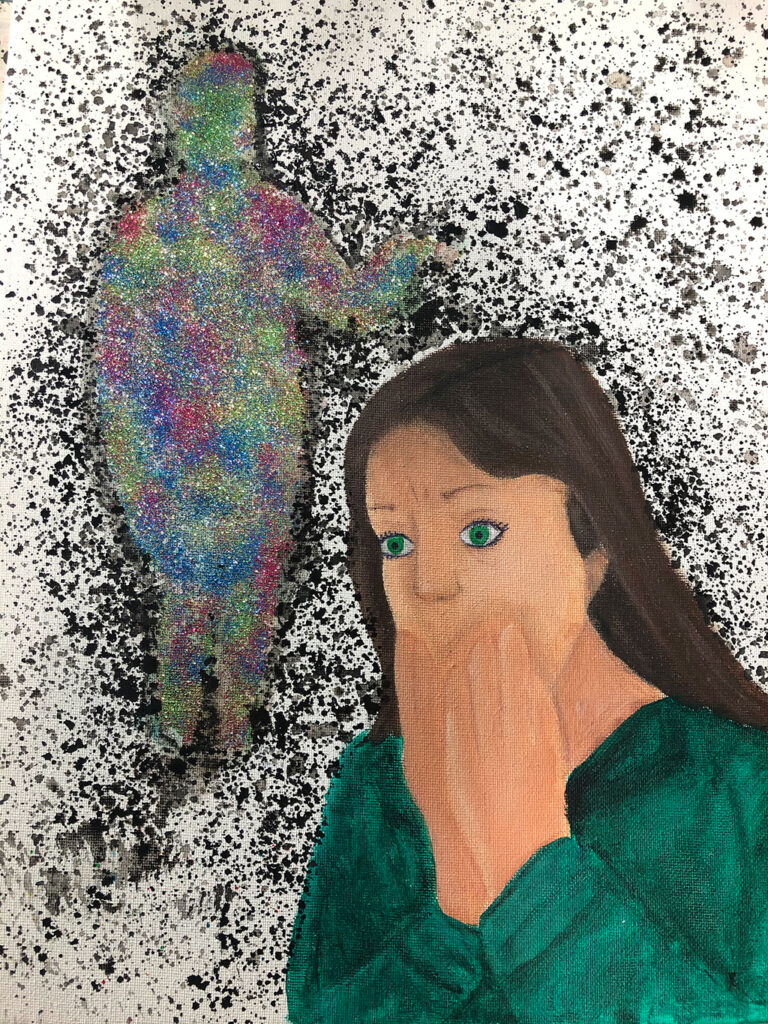
Imogen Whittle
Previous Education: The Kingswinford Academy
Destination: University of Wolverhampton – BA (Hons) Fine Art Degree Year 1
My work is about spiritualty, paranormal energy and religion. The ideas for my work came from contextual research and sketchbook experimentation, of which I developed through use of different drawing and painting medias and styles.
Research on spirituality has informed my practical work as the course has porgressed. It has influenced what colours I use in my painting and how I apply them. For example, the glittery colours used in my work represents the Chakra colours, which is believed to be a person’s Aura in religions like Buddhism, as well as suggest the paranormal. This interest in glitter links back to my research into crystals, as it represents the shine you get from crystal.
The research in to religion has influenced my compositions, as the figures and hand gesture of my paintings hint at religious narrative such as the New Testament story of the ‘Pharisees and Tax Collector’.
From a contemporary art point of view I have been mostly inspired by the illustrator Matthew Tak. The message he portrays in his work is often about spirits and being calming, which was also what I wanted to portray in my final outcome. The artist Lydia McGrigor inspired the media and style of which I painted my ideas as I found her painting style unique and something I wanted to attempt to replicate in my own work to my own. Youqing Wang much like McGrigor also inspired my painting media, tone, and style. Andy Warhol inspired the bright combination of colours I used on the left figure.
Group discussion helped me gain other opinions and viewpoints, which further helped me adapt and develop my work. In my project I could have used a broader range of medias like, photography, projection, and printmaking.
I have achieved everything I had set myself to complete in my proposal. However, I could have developed how I planned my practical work, as I did not question possible outcomes.
For example, if the finished piece were to look different than my original idea.
My final outcome is pictured to the right, I have named it ‘Manifestation of a loved one’, as it depicts a friendly and related spirit that brings comfort after passing. Again, this links back to Matthew Taks work names ‘Calming Spirit’. This painting if the final developed piece, from a journey of experimentation and research. This encapsulates all of my research done through the project and also makes links to artists I have inspired from. As well as feedback from peers, which helped me when planning this piece beforehand.
The key things I felt I have learnt are; to link my work to research more, use a broader range of medias, keep experimenting and developing work, question what I would do if this piece’s outcome differed from intention. The most significant thing FAD has taught me is to keep trying different methods of practical work, and always experiment and develop work. As well as ask for peers’ input/opinions. I could develop this learning in my course at University by being more open minded to changed and development in my project.
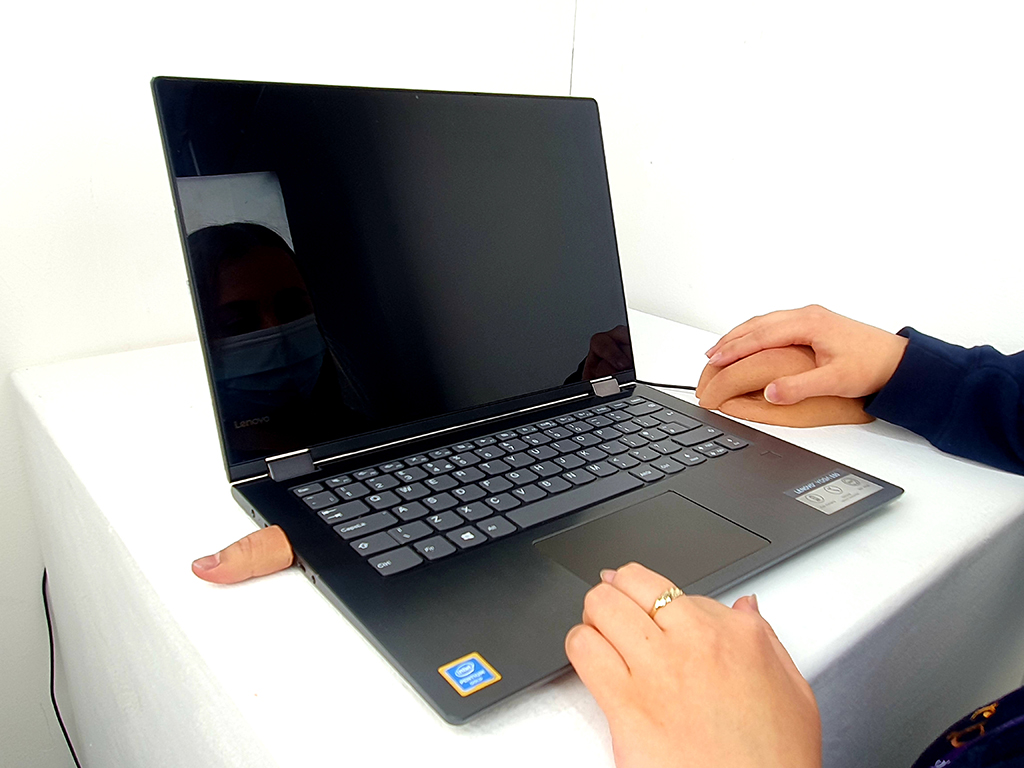
Aaisha Yasir
Previous Education: Thorns Community and King Edwards VII
Destination: BA (Hons) Product Design and Technology in Aston University
Are You Human’ is my take on how Artificial Intelligence (A.I.) is slowly advancing to the point where it is difficult to distinguish between real life, and man-made, I wanted to explore this theme by creating technological objects such as a computer mouse, telephone and a USB stick that were disguised as hyper-realistic body parts. This idea of A.I. stemmed from my fear and fascination with A.I. as well as the portrayal of technology in movies and games. I wanted to take a futuristic approach, but also create something unsettling for the audience.
My ideas began with sketches of body parts and matching them to different items I wanted to combine them with, soon after I began sculpting features using clay leading me on to molding using alginate and plaster, as I expanded my range of products, I started to develop a ‘quirky’ theme in my work influenced by Shishido Mazafaka and Gina D’Aloisio, both sculpturists who play with the human form by giving them new properties. I also began noticing surrealist themes in my work, taking inspiration from well-known works such as the ‘Lobster Telephone’ by Salvador Dali, which influenced the ‘Foot Telephone’. Prosthetist David Cronenberg also pushed me to break boundaries and explore different materials and techniques as well as looking at my work from a prosthetist’s perspective.
Throughout my project, I had regular discussions with tutors and peers which helped me expand my ideas as well opening to new artists. This was especially useful for me in the contextual sector, as I was able to learn about issues outside the art world which I could also implement into my work. Regular group crits were particularly important in my project because it allowed me to present my work, which will benefit me professionally, as well as receiving feedback and ideas from many different people. Much of the feedback I received was to think about the presentation of my final pieces and the photographing sector of my work, which later I made a dedicated webpage for.
Planning the timescale for my project and creating deadlines, was probably one of the things I struggled the most with my FMP, especially because most of the work had to be done at the studio, however, I was able to resolve this by coming in extra days as well as sorting out priorities, of what work could be done in studio and what could be done at home, I also didn’t consider the drying time of the plaster.
This FMP has given me an insight into what a product designer does as well as an idea of what I’ll be doing in college, this project has also allowed me to work under difficult situations such as the pandemic as well as my laptop breaking, which I feel has challenged me. This Foundation Art and Design course has allowed me to gain responsibility for my work as well as independently generating my ideas, I feel that this course has also allowed me to develop my style and confidence which help me develop as an artist.